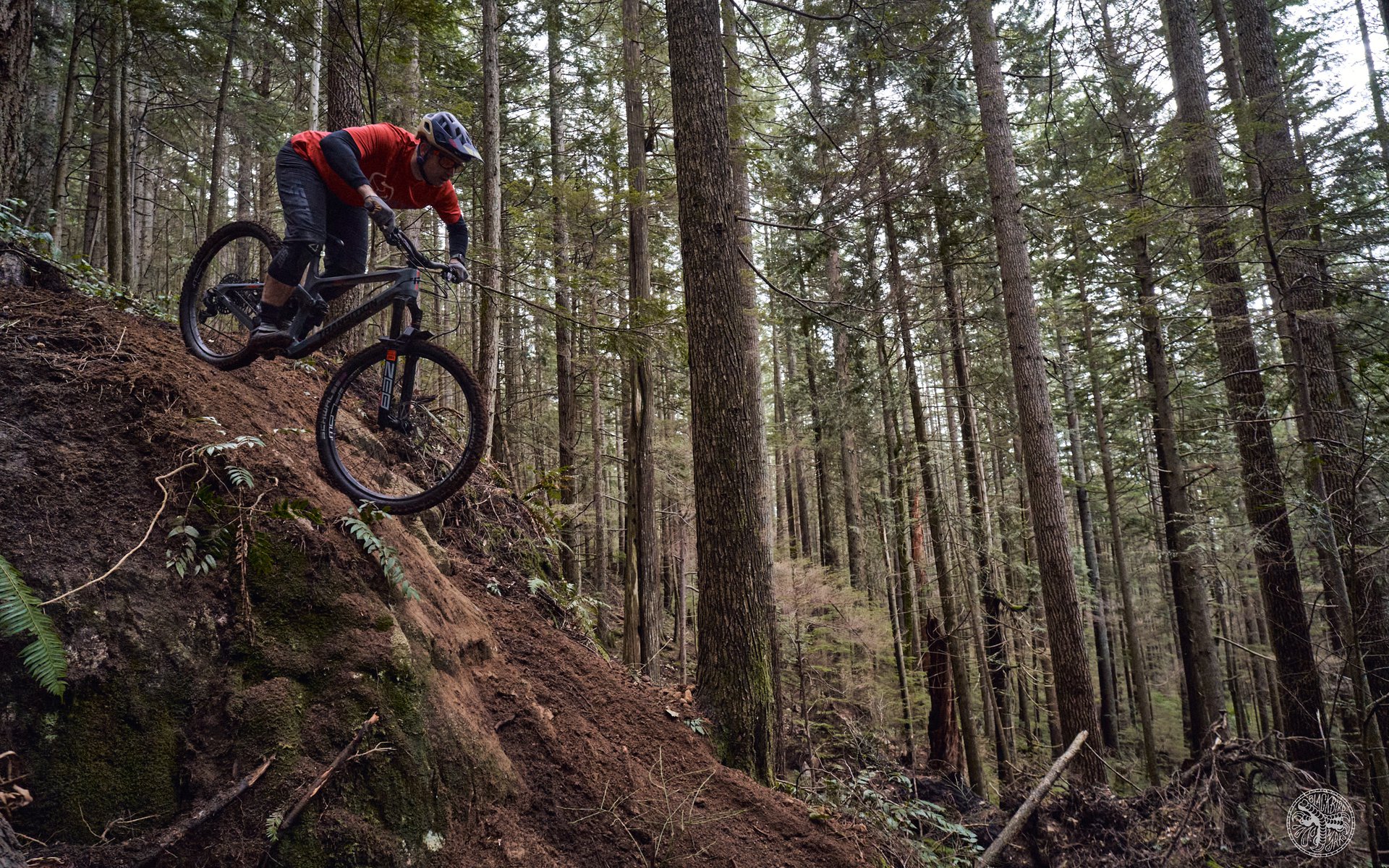
Full Review
2022 Transition Spire Review
Transition launched the Spire, a new platform for the brand, in June of last year. I got my hands on one in October, and since then it has been ridden everywhere from the Whistler Bike Park to very pedally technical XC missions. I have to give Transition a couple props off the top. The bike comes in a box with a Boombox motif, and huge "Engineered to Party" motto, which sets a mood before you even see the bike. Transition's ethos seems to be entirely about having fun, and as far as I'm concerned, that's entirely the point. Next I like the name. Naming new things is hard, and I think Spire is an awesome bike name. I've already gone over all the spec and details of the bike in my First Look article. For the TLDRers I'm testing the carbon frame, GX build-Spire that retails for $8,299 CDN. Since we got all the nerd stuff out of the way, I'll be concentrating on my opinions of the Spire, and in particular how it rides, in this article.
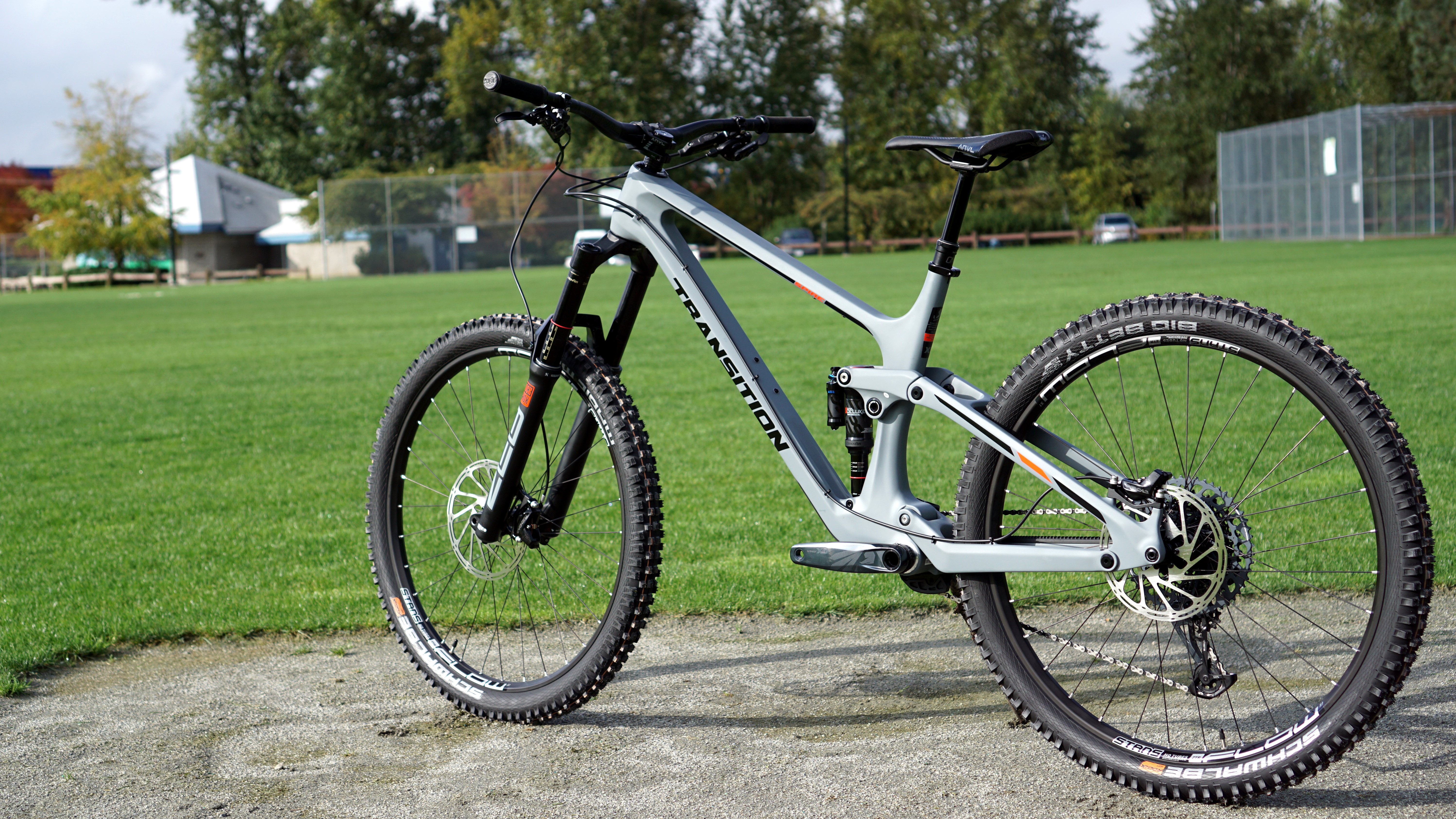
The Transition Spire I have been testing is the Primer Grey, carbon frame, with the GX build. Pretty!
My first impressions of a bike always focus on how it looks. Call me shallow, but your first interaction with any bike is with your eyes, and bikes these days have to look good. I love the clean, simple lines of the frame but I'm not wild about the primer grey colour on the Spire I'm testing. I mean, the grey is fine for a muted, inoffensive tone, but I prefer some colour. I do however LOVE that purple the carbon Spire is also available in. The graphical additions are understated, and I think they work well with the lines of the Spire. The only possible improvement would be a little more visual differentiation in the Spire from Transition's other bikes. Folks always recognized the Spire as a Transition, but many thought it was a Sentinel or a Patrol. Build quality0wise the frame looks nicely put together. All the finishing details are well executed. Fit and finish of all the other components to the frame are flawless.
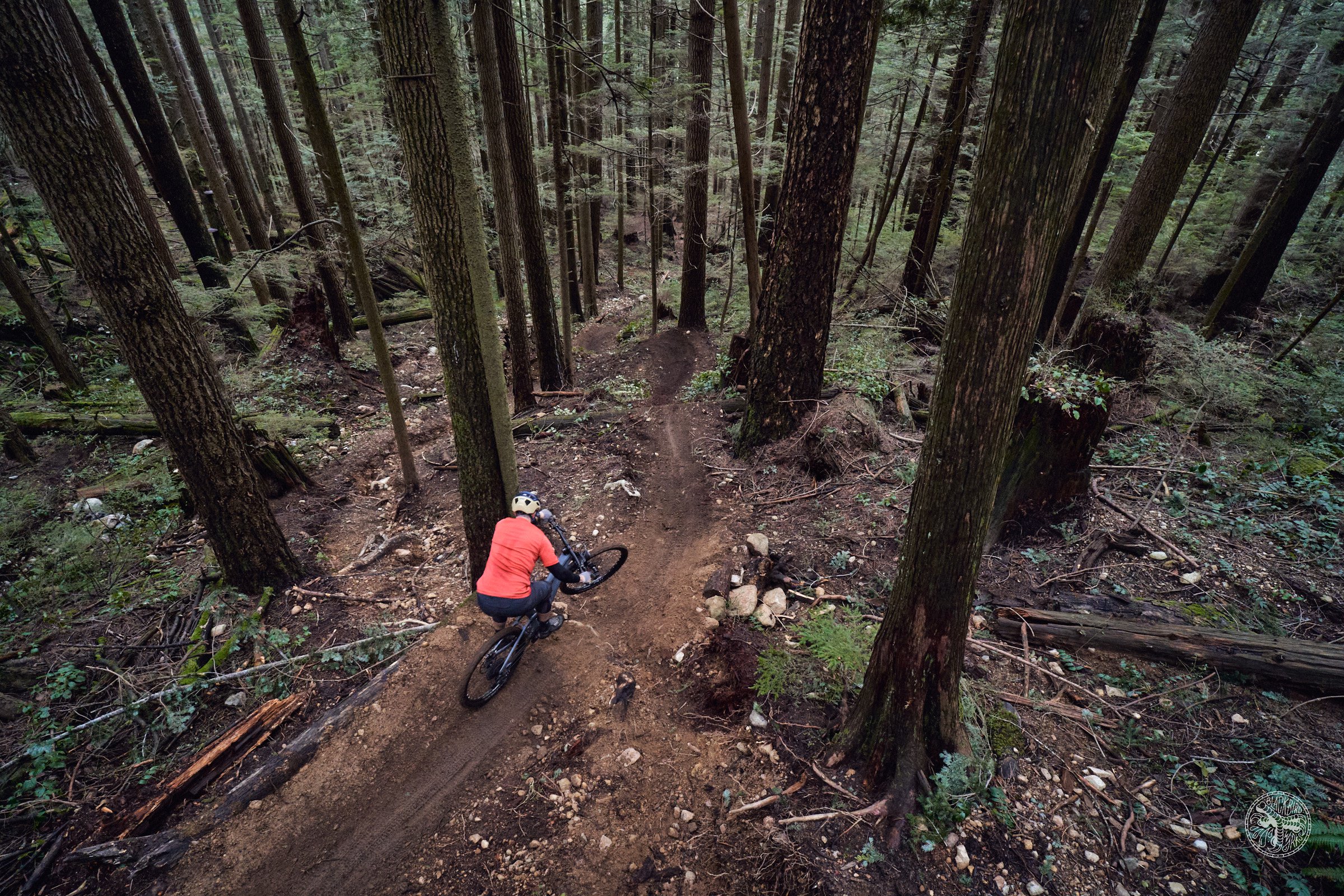
Engineered to Party sums up the Spire well. Always a good time.
Sizing and Geometry
I picked the size XL Spire and in the high setting this means a wheelbase of 1,322 mm with a 63° head angle. In each of the sizes, the Spire's wheelbase is on the long side, with an aggressively slack head angle. The wheelbase of the XL I'm on is equivalent to the longest modern trail bikes* out there, and Transition makes an even longer 1,352 mm wheelbase XXL Spire. Kudos to Transition for making a bike size for the properly tall folks. The seat post angle is relatively steep, keeping my weight forward in the chassis on steep climbs, so the front wheel rarely wanders or feels light. Even with the steep seat tube angle, the roomy front centre keeps the seated climbing position comfortable.
The long front center on the Spire allows for ample room to move my weight around when descending, which makes the bike feel stable and planted. While Transition doesn't alter the rear center with each frame size, there are two different rear centre lengths for the five sizes; 447 mm on the Small, Medium, Large and 453 mm on the XL and XXL. A different size on each would've been nice, but I think the compromise Transition has chosen works well. I like the 453 mm stay on the XL, and I think this would be too long on the smaller sizes. I found the ratio of front center to rear center rewarded a centered body position when descending.
There is only one geometry adjustment on the Spire, and it's a Low or High setting. In the High setting the head angle is 63° and in the Low setting the head angle is 62.5°. I really like how the Spire rides in the Low setting in the bike park, it's just so stable and fun at high speed. But on the slower, more technical trails beyond the park I preferred the slightly higher ground clearance and steeper 63° head angle. Since most of the review period was after the bike park was closed, the Spire spent most of its time in the High "Steep" setting.
*Note - Tim is a downhill racer, a breed of riders that refer to anything without a dual crown as a 'trail bike.' - Ed.
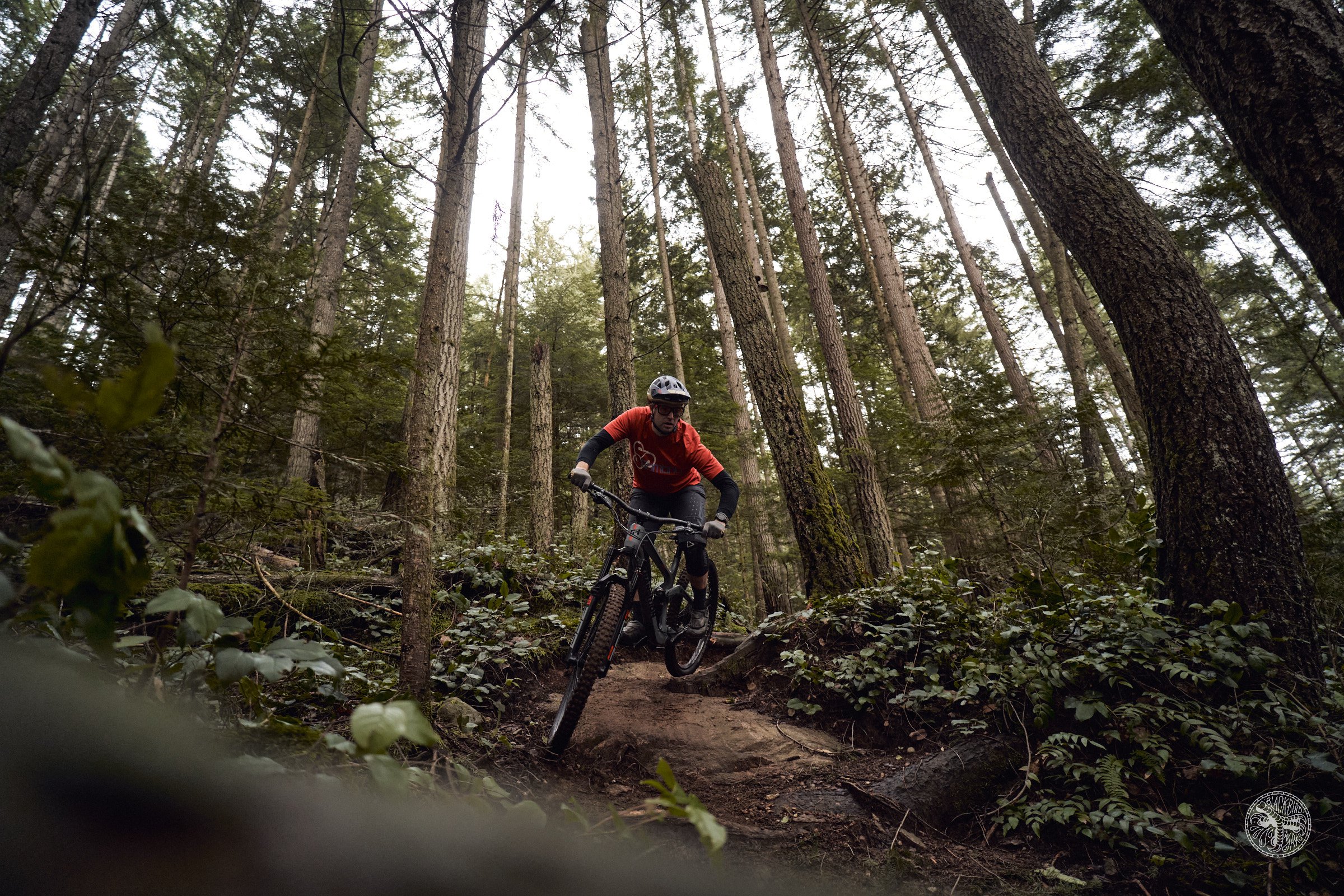
Regardless of the long wheelbase and slack head angle, I found the Spire surprisingly easy to turn.
Ride Impressions
Climbing
I'm impressed with how efficient the Spire is to pedal. You wouldn't think you're on a long travel bike. Transition claims a bike weight of 33.3 lbs for the medium, I measured the XL at an impressively light 33.5 lbs with a heavier-duty Super Gravity front tire, bottle cage and pedals. With the Climb Switch on, and with the lighter, harder compound Schwalbe tires, the Spire feels almost effortless to move around. Even climbing technical terrain I thought the Spire was easy to pedal. The longer length and slack head angle is going to make the Spire less agile, but I found I was able to get up moves / features I normally struggle on. The 30 tooth chain ring, paired with the ultra-wide 10-52T cassette made the steepest climbs a breeze. The bottom bracket on the Spire is relatively low, so while I liked the pedal clearance of the 165 mm cranks, I'd personally like to see 170 or even 175 mm cranks on the larger size Spires.* The Spire did a great job of minimizing unwanted suspension motion while pedaling when the shock was in the open mode. The climb setting on the Super Deluxe is fairly firm, which further improved the Spires pedaling efficiency.
*Maybe my preference for longer cranks is old school, and I realise this is a horses for courses thing, but for a number of reasons I prefer a 175 mm crank on the trail bike.* We can debate the details in the comments! With Transition already spec'ing size specific bars, maybe bikes should have size specific crank lengths too?
*Told you - Ed.
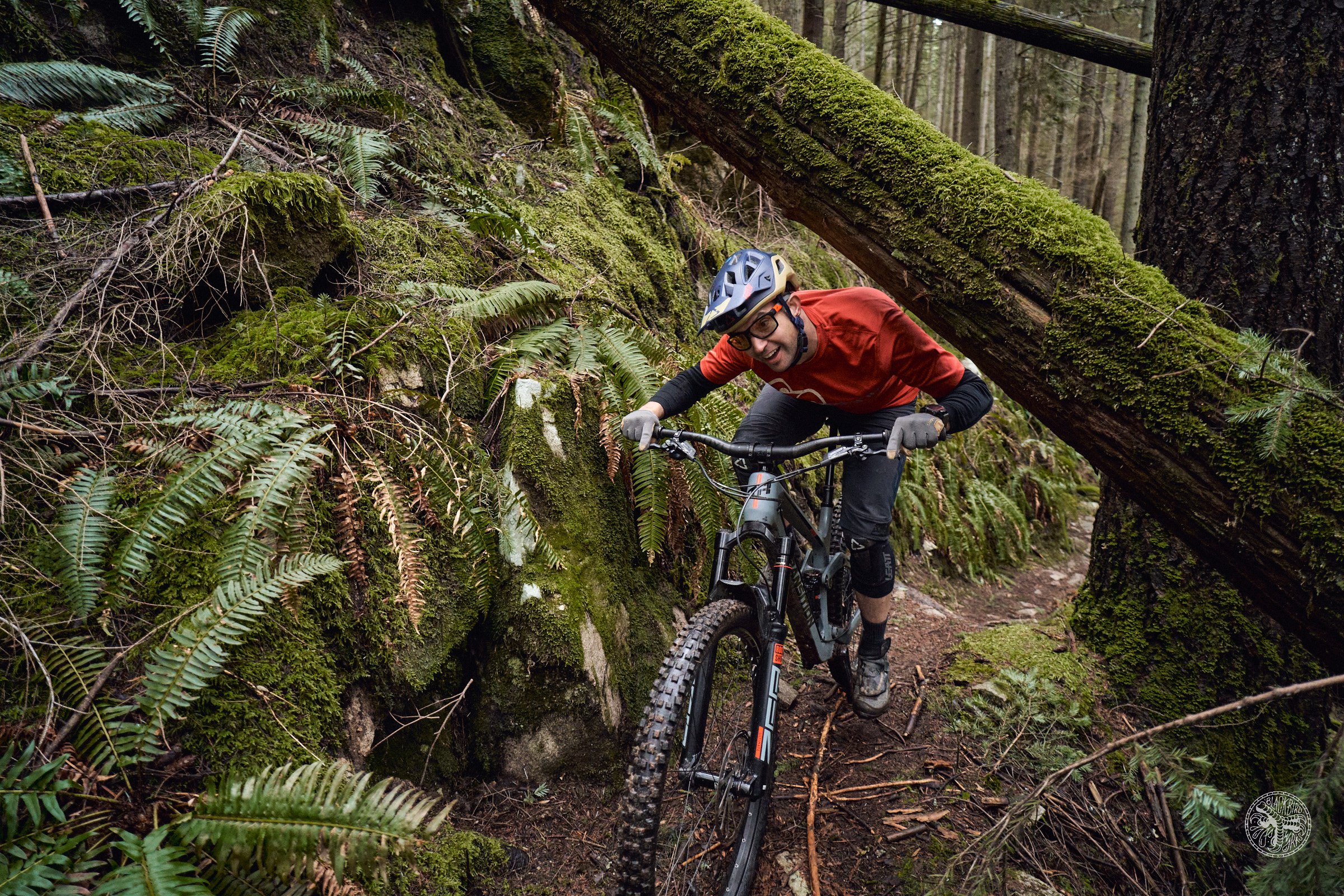
Goofy climbing picture, because we didn't come here to see a fat man climbing a long travel trail bike.
Transition's ethos of "Engineered to Party" and moniker of the Spire being a "nimble bruiser" are spot on.
Descending
In a word, the Spire is a party! It has a sporty, supportive feel, but with enough travel to take on the roughest tracks. While the length and slack head angle gives the Spire fantastic stability, it also has a wonderful eagerness to it. I think Transition nailed the spec of the the Super Deluxe shock. This is the first air sprung bike I've ridden in a long while where I liked the stock volume spacer spec. The Spire offered good support at sag, felt surprisingly supple, and ramped nicely deeper in the travel into a mellow bottom out. I was constantly surprised at how supportive and sporty the Spire would feel on relative benign sections of trail, which you'd expect to translate into a harsh mess when the trail got rough, but it just doesn't on the Spire.
The Spire frame is reasonably stiff, but it's not the stiffest thing out there. I have some witness marks from the tire rubbing the stays, but I think it strikes a nice balance. I like the long wheelbase of the Spire and I find the length makes the bike easier to ride through rough or steep scary technical features. You'd expect a long, slack bike like the Spire to be slow and tough to turn, but I found the Spire a joy to turn. I found I could ride with a neutral centred body position through almost anything on the Spire. It's easy to weight the front tire enough to hook through flat corners, and I never felt like I had to move my weight far from centre to unweight the rear end into a cutty, or to prepare for a large jump.
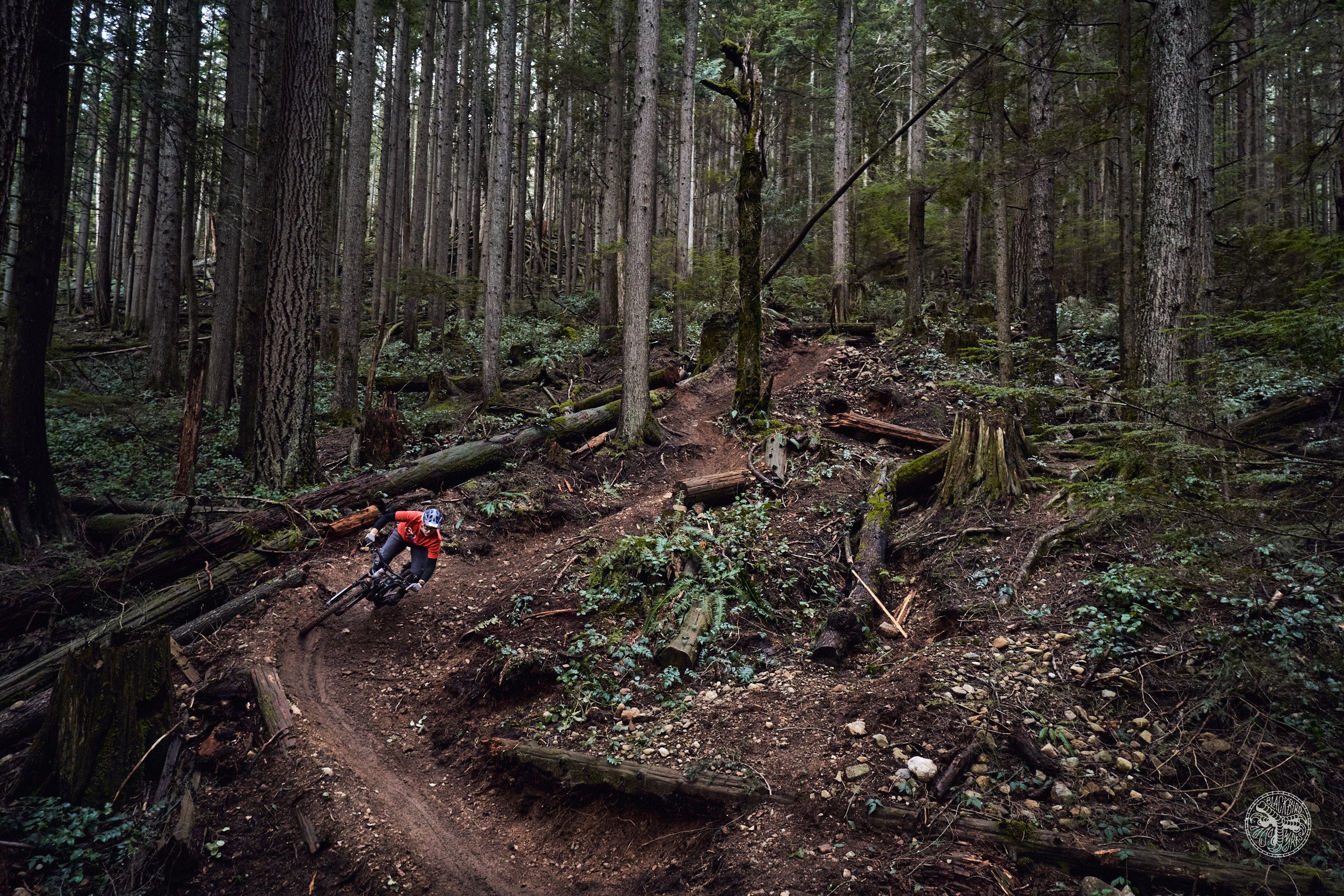
Spire country.
A combination of the reasonable weight, and supportive nature, the Spire was a breeze to pop and jump. I found myself picking far off landing zones, and popping off small features to see if I'd make it, just because the Spire is so much fun to get airborne. Transition has done a good job of adding sound damping bits to the Spire, that resulted in a relatively quiet ride down even the roughest lines. I like quiet bikes, and while I normally put rubber tape on the frame to quieten things, this wasn't required on the Spire. The durability of the Spire seems excellent. Through a very wet fall and winter the Spire saw alot of use in the rain. No issues to report with any of the bearings / pivots.
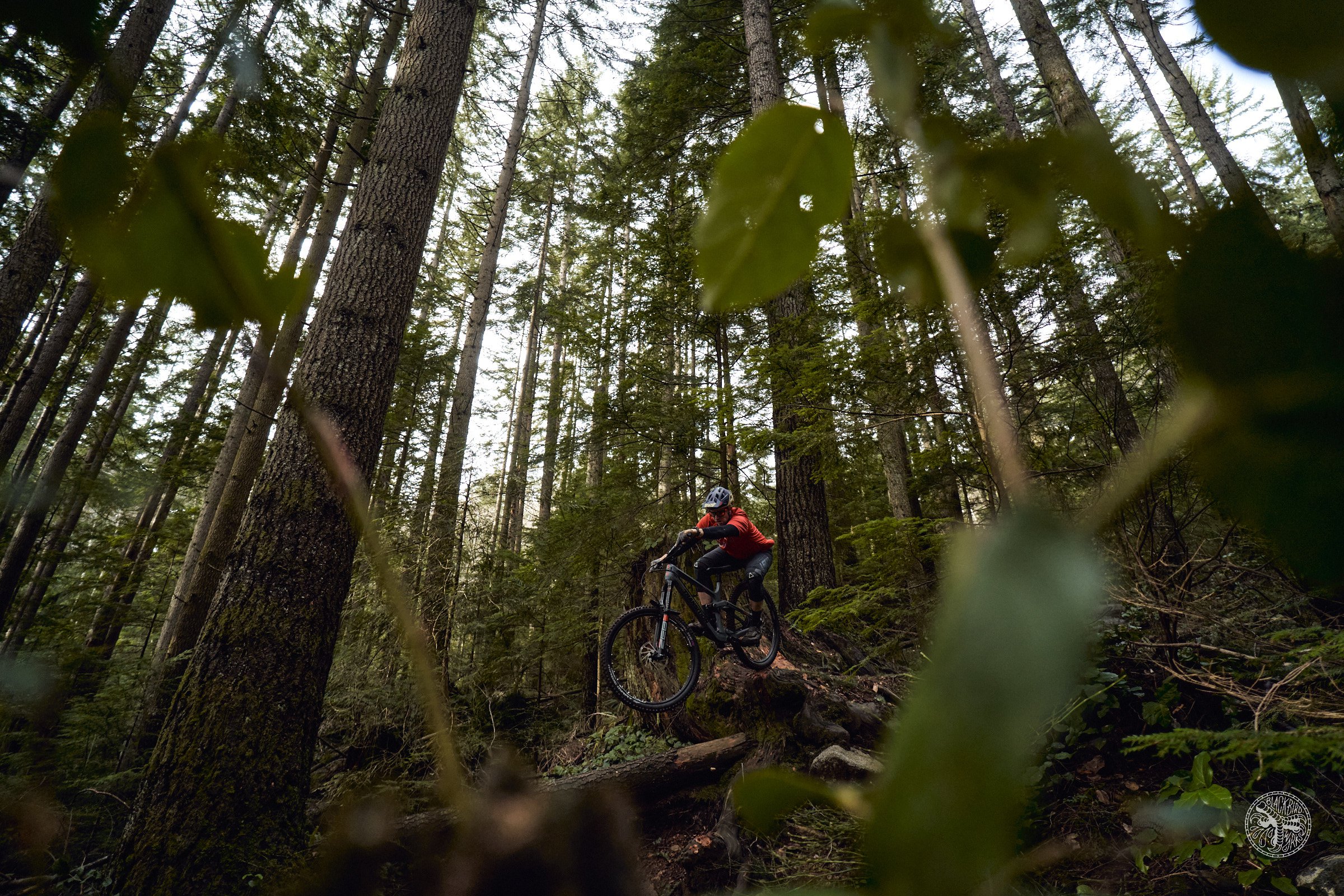
Even over the janky awkward drops the length of the Spire wasn't an issue.
Component Check
Suspension: the Rock Shox Zeb and Super Deluxe were great as to be expected.
Brakes: the Code RSC brakes were awesome, and love that the Spire comes with a 220 mm front rotor.
Seating: some may love the 210 mm drop OneUp post, but I found this was actually too much drop for my short legs. Thankfully it's easier for me to reduce the drop than it is for those with long legs to stretch the drop. The OneUp post did get sticky towards the end of the review, and likely needs a simple service. The house brand ANVL Forge saddle was comfortable, and durable.
Tires: the stock Schwalbe Soft Magic Mary was too hard for service around these parts. After a few rides I switched this for a softer Ultra Soft Magic Mary for the remainder of the test. For a 170 mm bike coming from the Pacific North West I think this is the biggest miss on the Spire part spec. I was concerned the newer Speed Trail casing rear tire might be a bit thin for use around here, but I was pleasantly surprised with no punctures or issues over the test period (which was not gentle).
Wheels: the Stans Flow S1 wheels were surprisingly good. A couple small dings here and there, but these held up really well. Tires were easy to install and remove.
Cockpit: I liked the bar and stem, and really liked the Sensus Lite grips.
Drivetrain: The GX Eagle drivetrain was flawless over the test.

The 220 mm front rotor spec from Transition is great, and certainly helped on long sustained descents.
Moans
As mentioned earlier, I think the front tire spec should be softer to better match the intended use of the Spire. The paint is on the thinner side, and after a few months of riding there is a large area of exposed black carbon on one chain stay. This is obviously caused by heel rub, but for reference I've never worn through the paint on a bike like this before. Wrapping the Spire might be a worthwhile investment. Not a bad bike if those are my biggest complaints!
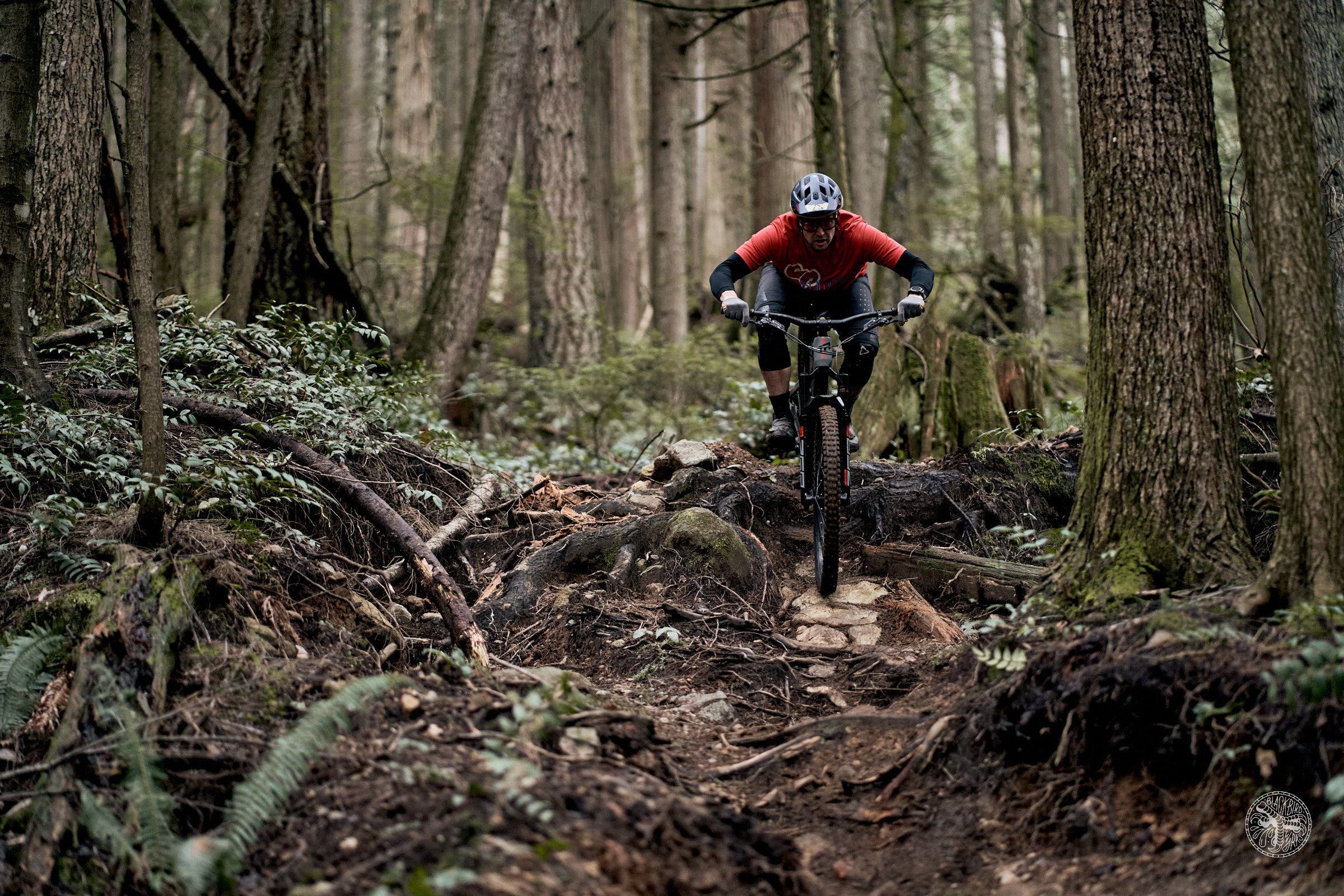
The long, aggressive geometry of the Spire make it stable through rough ground, which I find gives me confidence to look further down the trail.
Bike Setup:
Fork - Rock Shox Zeb:
Air Spring - 75 psig* with 3 tokens.
Compression - 4 clicks out Low Speed, 3 clicks out High Speed.
Rebound - 8 clicks out.
Shock - Rock Shox Super Deluxe:
Air Spring - 210 psig* with stock tokens
Compression - 4 clicks out
Rebound - 3 clicks out
*Tim is an engineer and apparently "psig" is engineer for PSI

Dank misty sends on the Spire.
In Conclusion...
The Spire makes an excellent argument for an aggressive do it all bike. I'm going to avoid any of the well worn clichés and say that I'm impressed with how easy the Spire is to pedal around all day, while still being perfectly comfortable smashing the bike park to bits. I've long said an aggressive 150 mm travel bike is the ideal middle ground, one bike for most folks. The Spire makes me seriously rethink that position. With how well the Spire pedals, reasonable weight, and aggressive geometry why not have this with more travel? It's just so much fun to ride everywhere. The Spire doesn't have the sheer bump eating capability of the pedalable high pivot bikes, but it's probably easier to live with as a daily driver with how easy it is to pedal around. Transition's ethos of "Engineered to Party" and moniker of the Spire being a "nimble bruiser" are spot on. I can't believe I'm saying that a GX build bike at $8,299 CDN is good value for money, but looking around at other comparable carbon bikes, the Spire seems well-priced. I think the Spire geometry, sizing and builds are well judged by Transition, and should suit a wide range of riders. It's hard to find many faults with the Spire. If you're looking for a new bike, regularly ride fast, rough, steep trails, and frequently pedal to the top, I'd recommend checking out the Transition Spire. It put a smile on my face every time I rode it.
Age: 41
Height: 183 cm / 6'
Weight: 87 kg / 192 lbs
Ape Index: 1.055 / +10 cm
Inseam: 81 cm / 32"
Preferred Riding: Gravity Mountain Bike
Bar Width: 800 mm
Preferred Reach: 500 - 520 mm (but this is stack and head angle dependent)
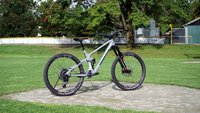
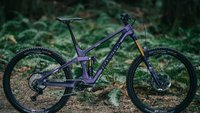
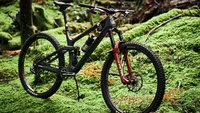








Comments
BenHD
2 years, 2 months ago
Deniz, you have to stop taking sexy photos. I can´t read the article without admiring the pictures all the time. It´s distracting af.
Reply
Tim Coleman
2 years, 2 months ago
I know right! Deniz killed it on this shoot. Writing articles where Deniz has taken the photos is brutal. It takes me hours of waffling to down select to the ones that make it into the article.
Reply
NewGuy
2 years, 2 months ago
Pictures were indeed top notch!
Reply
Deniz Merdano
2 years, 2 months ago
And it was a Sunday with million people on the trails... This one took patience!
Reply
Ddean
2 years, 2 months ago
Ive got the purple Fox XT Spire.
Some thoughts:
1) Yes it has a lot of travel but I blow through travel on this bike like I have in no other, and Im far from a big hit rider. I expected that Id use only 150ish of the 170, but I use the full 170 all the time. It does not feel harsh at the top of the stroke.
2) Long bike - I went with a medium for my 5'9 versus my usual large. No regrets for the terrain I ride - which tends to be more technical jank than fast flow.
3) Stiffness - I have not perceived any of the rear flex that the review mentions.
4) A single bottle is a very tight fit in the medium.
5) First couple rides had a lot of pedal strikes. Ive figured it out better now and theyre not really a problem. I ride in the high position - never tried the lower - dont see the benefit for my riding.
I adore this bike. Super versatile and Im hitting things that I have not outside of a DH bike. It feels like a trail bike to me pedaling it around.
Reply
Guanche
2 years, 2 months ago
Great Review! Big shout out to Chris Porter for pushing the envelope in the right direction!
Reply
Jerry Willows
2 years, 2 months ago
I'm still baffled it took this long... a bike is just 2 triangles.
Reply
Pete Roggeman
2 years, 2 months ago
Edit (thanks T-Mack): Math11 me reports that triangles are hard!
Reply
T-mack
2 years, 2 months ago
So was Spelling 9 apparently ;p
Reply
Suns_PSD
2 years, 2 months ago
Transition nails it again.
Crank length AND BB height should be bike size specific so that taller riders can run longer cranks (and vise versa) and when the outside foot is in the down position the weight is the same distance from the ground for different sized riders so that the bikes handle the same.
Also for ground clearance: my wife on her size small & 165 cranks should have the same ground clearance as a 6'2" rider on an XL on 175 cranks. She doesn't need 10mm extra clearance!
Reply
Pete Roggeman
2 years, 2 months ago
This is an interesting point. I would hypothesize that while there should be a defined pedal clearance envelope for every size bike, the more important target would be a similar Center of Gravity based on avg weight of users for each frame size if your goal is a unified handling characteristic. In your wife's case, if anything, slightly less clearance but only as a byproduct of chasing a lower CoG.
A heavier rider on an XL may need a little more room than a lighter rider on an XS (though if they're running the same sag and obviously different spring rates maybe my point here is moot?)
BB drop is the second proportion I'd be curious to understand as it relates to CoG and differing frame sizes. Would 120-lb and 190-lb riders with the same BB drop experience different centers of Gravity? I'd think so unless, again, sag and spring rate mostly nullify the difference.
Enginerds please chime in. This coukd easily be a future 2-minute expert.
Reply
Morgan Heater
2 years, 2 months ago
At 6', riding an XL bike, I like my 165mm cranks a lot.
In a perfect world, I think bikes would be sold with an allowance for the following, and people would get to pick what they wanted without having to add replace:
1. Crank length
2. pedals
3. bar rise
4. grips
5. saddle
Reply
Tim Coleman
2 years, 2 months ago
Yeah, the more I talk with folks around my height, the more everyone has a different personal preference. So it's always going to be tough for the folks that spec bikes.
And the rest of your list is obviously all personal preference as well. Some bike shops might be flexible in doing a swop for parts, but probably with a charge as selling a bike take off is always going to be more difficult than a new aftermarket part in the original packaging.
Reply
Jerry Willows
2 years, 2 months ago
people who like to spin should be on short cranks, I like to use low cadence so long cranks for me.
Reply
Morgan Heater
2 years, 2 months ago
Yeah, I don't think it's practical, but it sure would be nice. :-)
Reply
Onawalk
2 years, 2 months ago
I don’t believe for a second that I can properly discern between a 170, and 165mm crank. Or 5 mm in chainstay, or reach, or h-bar width, etc.
I think we all get caught up in numbers, in an effort to differentiate ourselves one way or another. I had this similar discussion with someone on PinkBike that was adamant they could discern minute differences. After that I talked a buddy into spending the day testing if he could tell any differences.
We swapped bars, I adjusted this that and the other thing, and the only think discernible was seat height. I even had his bars slid to the left by 10mm, didn’t notice.
I think there’s an article in this idea
Reply
Morgan Heater
2 years, 2 months ago
I definitely notice bar height and seat height, but probably not a 10mm change. My 40mm rise bars are much more comfortable both climbing and descending than the 15mm rise bars my bike came with. Crank length is more about pedal strikes and climbing for me. Seats and grips are also a comfort issue...
Reply
4Runner1
2 years, 2 months ago
Agreed. If your back is shite like mine, a 10 mm increase in bar height is definitely noticeable.
Suns_PSD
2 years, 2 months ago
This hasn't been my experience at all, with cranks being the really big change for me personally. VERY & shockingly noticeable. I've tested the 3 primary sizes.
Effective reach is another one, and I can generally tell right away what I need to swap my stem too on a new bike because my hands naturally want to be in a notable different spot.
I've been called the Princess & the Pea however.
Reply
Lynx .
2 years, 2 months ago
Onawalk, just because you have the sensitivity or a piece of concrete, doesn't mean that's every body else :-\
I can drastically notice and feel a 5mm difference in bar height, the difference between this feel way tall and this feels perfect, I own 2.5mm headset spacers and use them. I also can tell the difference of MM in saddle height and am very aware of the difference even between 2 padded shorts with different thickness pads and I adjust the saddle height accordingly - if my saddle is 5mm to high or short, I can feel and notice it.
I can definitely tell the difference between a 175mm and 165mm crank length, feels WAY different, much easier to spin the 165 and much harder to push a harder gear compared to 175mm, have never had a 170mm to try against the 175mms.
Reply
Velocipedestrian
2 years, 2 months ago
6. Dropper.
Reply
Vincent Edwards
2 years, 2 months ago
Yeah, I’d add dropper length and shock tune to that list too.
Some bike makers (like ibis) will spec different shock tuning by size- but being able to choose based on your weight would be even better. I’m close enough to average, but would imagine riders at either end of the spectrum of height and weight might want better choices.
Reply
mike
2 years, 2 months ago
Bar rise , hell yay. Totally different feel than . Just raising the stack height. I like some stem rise as well. Big fan of the Renthal FAT bar and a Apex stem combo.
Reply
Onawalk
2 years, 2 months ago
It sounds like you’re buying a frame a building it up….
Coptic sells a rolling chassis, which looks to be a great way to use buying power for the expensive oily bits, and purchasing your own personal touch points.
Reply
Onawalk
2 years, 2 months ago
No two riders, on two bikes will experience the same handling regardless of crank length, or proportional this, or different sized that. We are all all built so differently, riding different trails, in different conditions, in an incredibly dynamic sport with little power, on lightweight toys.
Try em all, find what works for you, try some more, have friggin fun out there.
Reply
Cam McRae
2 years, 2 months ago
Great thoughts and ideas and I totally agree about your contention re. small differences being indiscernible. I switched to shorter cranks without noticing anything at all. I don’t think however, that means they can’t create a performance difference. So sometimes a sense that something is better might be about noticing the performance difference without being able to feel whether your bars are 780 or 790.
Reply
Onawalk
2 years, 2 months ago
Totally fair, and really almost impossible to test/quantify (all those pesky opinions and biases)
Merely talking about myself, I find mtb to be so dynamic that I find it hard to believe it’s really that discernible. There are a lot of people who will vehemently tell me they can feel every mm of difference, and seem to get real defensive when it’s challenged.
During off season, I try to take note of different measurements, etc. Then change everything to see if I’m stuck in a rut. Not once have I put things back to exactly where they were, sometimes making big changes.
We all grow, bodies change, weight shifts, flexibility decreases, skills change, the idea that your bike setup from 3 years ago is still optimal today blows my mind.
Be good to one another out there.
Hey NSMB, if I put together an article about it, wanna print it?
Reply
Cam McRae
2 years, 2 months ago
I had this thought before you offered actually! Please send me an email - [email protected]
Thanks!
Reply
Cade Gocal
2 years, 2 months ago
Maybe Chris Porter was correct after all! Looks like a Taiwan made geometron to me with Kinematics aimed for a air shock. Shame you can issues with the oneup post as I’ve heard more of the same from others! But damn I wanna order a 240 anyways
Reply
Cam McRae
2 years, 2 months ago
Generally OneUp dropper “maintenance” is simply unscrewing the collar by hand and applying some lube, which is likely what this one needs.
Reply
Bagheera
2 years, 2 months ago
Great review. I can't keep wondering why everybody seems to be so enamored with the Spire's climbing characteristics, though. I own an XXL alloy, bought as a frame and built up mostly with parts from my old bike (shorter cranks and shorter stem, though). My old frame was a Bold Unplugged Vol. 1, so by no means a "small" bike. Having demo'd an XL carbon Spire, I thought I knew what to expect. Nope. After the first climb, I was ready to sell it. Seems to suck all energy and all the joy out of climbing. Lowering the bars helped some, and I'm kind if getting used to it, but I'd have to think hard whether the descents would really be worth it before taking it on an all day ride or if I should rather opt for my clapped-out trail bike. A week ago, I did the same climb on two subsequent days. Once on the Spire, once on my old 2014 Trance. Same conditions. 59 minutes on the Spire, 50 on the Trance, and it's a climb I can do in slightly over 40 minutes in summer. Give the Spire a steep, slippery climb and it will grind up as long as you can pedal and never lose traction, but try to get anywhere fast... no joy.
All thoughts of selling it are forgotten once you point it downhill. As long as you stay over the bars (I'll have to up my push-up game), I've never ridden anything that could compare.
Caveat: I've only ridden it in the low setting so far (2 months). Because, if you can have a 62.5 HTA, why wouldn't you? Will try the high setting at some point.
Reply
Tim Coleman
2 years, 2 months ago
Thanks. Are you using the same tires and tire pressures on your Spire and your Trance? I find tire selection has a huge impact on the effort to climb / pedal a bike. The Spire frame is relatively light, the climbing positive is great, and with the Super Deluxe being quite supportive I can't see where the frame is responsible for the loss of efficiency you're experiencing. So I suspect what you're experiencing is caused by something in your build.
Reply
Bagheera
2 years, 2 months ago
Of course the Trance and the Spire do not have the same tires, horses for courses and all that. As pointed out above, the Spire has almost the same build as my Bold had before, and while the Bold did not climb as well as the Trance (maybe a 2 minute difference on the same climb, if that), there is a significant difference between the Bold and the Spire.
The alloy frame is not light (at least according to the bike builder on Fanatyks website, I have weighted neither the frame nor the complete bike).
I don't see how the frame could be responsible either, OTOH, I don't see anything else (the shorter cranks, maybe?). Wanted to try a different rear tire last weekend, but it didn't hold air (for once, not my fault, according to the LBS).
FWIW, I felt the same about a Sentinel I demo'd three or four years ago. Traction on steep stuff like a fat bike, but quicker climbs were not enjoyable (or possible). Maybe something about the Transition geometry that doesn't work for me, although I didn't notice it on the demo Spire or the demo Spur.
Reply
Onawalk
2 years, 2 months ago
Interesting,
Currently running an alloy V1 Sentinel, and it’s a capable climber, but by no means does it feel energetic (prolly something to do with the amount of sag).
I swapped to a Cascade link, and actually found the biggest difference on the climbs, it had even more traction, and was more supple. Compared to a light weight trail bike though, and it definitely falls short in the energetic department. On flat and undulating terrain, it’s great, and pointed downhill, it was a massive eye opener.
Medium alloy Spire on order, and I assume it’ll ride very similar to the Sentinel with the Cascade link. It’ll get you there, but it’s not inspiring you to push harder. I have a feeling the “tuning” of the carbon frame, along with increased stiffness adds to a more sprightly feeling when climbing
Reply
ohio
2 years, 2 months ago
Yeah, the carbon frame is REALLY light for the category at 7.6lbs (3.45kg) w/shock, but the alloy frame is REALLY heavy at 10.6lbs (4.81kg) w/shock. Air shock is typically bang-on 1lbs (.45kg). Not sure how that happened. '22 Spec SJ EVO is a 1lbs diff between carbon and alloy; '22 Nukeproof Mega 29 is actually the same weight for the two materials. Both of those alloy frames are about 7.25lbs (3.3kg) w/o shock, or 2.5lbs lighter than the Spire alloy w/o shock at 9.6lbs (4.4kg). Weight isn't everything - I think the 1lbs diff on the SJ EVO is irrelevant - but 2-3lbs is pretty hard to ignore.
Reply
the prophet
2 years, 2 months ago
I had an alloy SJ EVO and a Carbon SJ EVO frame in front of me, Weight difference was just over 2 lbs which is pretty standard for carbon vs aluminum construction. I kept the alloy SJ EVO, and have an alloy Spire. Unfair to make a direct weight comparison as the Spire has more travel and it much burlier.
I don't think the alloy Spire is super heavy, the carbon one is just super light. Over 2 lbs lighter than a carbon Enduro frame.
Reply
ohio
2 years, 1 month ago
I've got the Spec Enduro at 3.25kg w/o shock, so .25kg heavier than the Spire carbon, i.e. 1/2lbs between the two. I'll have to defer to you if you weighed the two EVOs. I was just going on what was told to me by Fanatik Co.
Weight is pretty subjective, but if Nukeproof can make an alloy enduro frame good enough for Sam at 2.5lbs lighter than the Spire, I feel okay calling the Spire heavy. Maybe a better comparo is a Geometron G1 at 3.6kg w/o shock, .75kg or more than 1.5lbs lighter.
Suns_PSD
2 years, 2 months ago
PLEASE PLEASE normalize a XC bike and something like a Spire for weight (i.e. strap weights to the frame of the XC bike) and test the climbing times on the 2 bikes on their standard drivetrains and then swap the drivetrains.
I think 70% of the climbing speed on an XC bike is the drivetrain (mostly tires), maybe 20% in the short rigid suspension & 10% in the weight difference.
But I want to KNOW!
Reply
Tim Coleman
2 years, 2 months ago
That's a good idea! I'm going to pitch this idea to the team.
Reply
Suns_PSD
2 years, 2 months ago
Also, try to use 2 bikes with very similar AS at sag just to remove that as a factor.
Also one smooth climb and one trail climb.
Reply
Mark
1 month ago
@Tim - did this idea ever go anywhere? From comments in different reviews and the response to the Buttercups A/B testing it seems there's a real appetite for comparative testing.
Reply
Brigham_Rupp
2 years, 2 months ago
Interesting. Based on my personal experience, I would give weight the bulk of the credit. I’m a fair bit slower on my spire than I was on my sentinel. Basically the same drive train, with locked out suspension, seated pedaling on long fire-road grinds. I would give pretty much all the credit to the small weight increase and the way it adds up over the course of a long climb. But I could be wrong. Particularly if the climbing were on actual variable/technical single track.
Reply
DadStillRides
2 years, 1 month ago
Sure, but how did your descent times compare?
Reply
Alex D
2 years, 2 months ago
That last photo is extremely epic.
Reply
Mario S
2 years, 2 months ago
I love the muted colors, stealth for life son!!
Reply
ehfour
2 years, 2 months ago
Any thoughts/comparisons on how it rides against the Carbon Sentinel?
Climbing? Descending?
For me the Sentinel is the perfect bike: all day pedals, pedals like a smaller bike, good for shuttles and the odd day at the bike park. In the back of my head, I keep thinking that more travel might be better..but better for what
I tested out running my fork at 170mm, but found the extra A2C height /HA or 62 degrees made it feel super choppered/sluggish
Reply
Tim Coleman
2 years, 2 months ago
I haven't ridden a carbon Sentinel a lot, so I can't make a direct comparison. But I have had a lot of time on a current gen Norco Sight with a 170 mm fork, which is similar. I don't feel like I'm giving up a lot climbing wise on the Spire vs. the Sight, I think that's more a function of tire / build choice than the frame. I think the primary difference in deciding between the two is the type of terrain you normally ride. The Spire is going to be more adept at rougher, steeper, faster trails. The Sentinel is probably going to be better on slower, smoother, shallower angle type trails. For our trails around Vancouver, BC to Pemberton I'd personally pick the Spire over the Sentinel. The Spire is going to be more appropriate in the bike park if that's your jam. But there are plenty of places I've ridden where the Sentinel would be the better choice.
Reply
ehfour
2 years, 2 months ago
Thanks Tim- its a tough call for sure- there are days we all have that bigger bikes are better and days were smaller bikes are better
I guess the only way to really know is n+1 and ride the sh*t outta both
Reply
Brigham_Rupp
2 years, 2 months ago
I went from a GX carbon Sentinel to the GX carbon Spire both with We Are One wheels. The geometry on the Spire makes climbing amazingly comfy despite the crazy numbers. My only complaint is the extra weight I’m lugging around. It’s totally fine, just not quite as quick as I was on the Sentinel. As for descending, the Sentinel was amazingly capable but the Spire just gives you a little more confidence and margin of error in the gnarliest terrain and on bigger jumps. I definitely feel more comfortable hitting big jumps on the Spire. There are times on tighter trails with smaller jumps that I miss the sentinel and feel like I have to work a little harder to keep the Spire up to speed and be able to clear stuff. The sentinel likes it fast and steep, the Spire even more so. I think in the end you can ride either bike on the same terrain, I do long XC type rides and full downhill shuttles here in Oregon. The spire makes the XC rides a bit less fun and the downhill runs a bit more fun! In short, you can’t go wrong but the Sentinel is probably the more versatile bike for a one bike quiver. If you’re not getting pretty gnarly at times, the Spire is overkill. Ideally I would have a Spire and a Spur. Perfection.
Reply
Suns_PSD
2 years, 1 month ago
I don't have a ton of experience on longer than 150mm travel bikes, but when I do ride them I notice when I did pedal that even if they have the steep STA & good AS, the fact is that 170mm travel bikes move a lot, even just to reach sag. For me, those larger transfers of weight had quite a bit of negative effect on pedaling performance.
The Spur doesn't even have a good AS number, but it still pedals well. I think short travel bikes can just do somethings that even with all the tricks longer travel bikes struggle to do.
Sounds like you need to add a DC bike to the Quiver!
Reply
Johannes Schmidt
2 years, 2 months ago
Thin SuperTrail sidewalls on the back did hold up but Soft rubber was too hard?
OneUp engineered the V2 a bit weird (the upper bushing is responsible for restricting the max travel of the post). So therefore the travel pins always crash into that bushing until they wander into it (which doesn´t take long). Problem: As soon as they do, the posts gets stuck somewhere in travel as the bushing is heavily deformed and hinders the posts movement.
Reply
cxfahrer
2 years, 2 months ago
I have checked that on both of my V2 lately after you mentioned that on mtb news, and the bushings don't show any marks.
Regarding the Spire:
Flex in the rear? Sounds alarming... I have been dreaming about the Spire in XXL for a while now, price aside, but still I am a bit worried about Trunnion mount (with the aluminum version and tolerances) and low BB. I think I would swap out the 165 crank immediately for 170 or 175. But with flex in the rear I definitely will look elsewhere, my riding technique is too bad to make up for such traits (owned an Alutech Fanes xxl once).
Tires on such a rig should be DD/Exo+ or SG from the start. But whether in front or rear you want the heavier one depends on the trails. I would put DD in the rear too, but when charging hard in the steep I would prefer a DD on the front too, it gives more support with soft rubber and you can run lower psi.
Reply
Onawalk
2 years, 2 months ago
You’ll be just fine, don’t sweat it. There’s nothing alarming about the rear flex. Most of the time it’s just mud and debris on the tire that causes what’s being noted here.
Currently have a V1 Sentinel, have swapped the link out for a Cascade one, and in doing so took some alignment measurements, absolutely within what would be tight tolerance expectations.
Thought I’d see how long the rear shock would go without a rebuild, had it rebuilt last week. So 4 years of abuse, on my only bike, with no real off-season.
Reply
Tim Coleman
2 years, 2 months ago
First off all bikes have some flex, and some flex is good. A bit of flex prevents the frame from being harsh and jarring. I'd say the Spire is on the stiffer side, but there are witness marks where the rear tire is rubbing the stays. But to be fair there are tire rub marks on the stays of every 29er I've ridden with only one or two exceptions. So I wouldn't be alarmed about my comment unless you're really heavy and really aggressive and need the stiffest thing out there.
As for the Trunnion mount, the fit on the Spire I'm on is good. The frame looks well aligned. Shock hasn't leaked oil or air, but then again I've only been on the bike for 5 months.
Tire wise I think Super Grav casing tires with a purple Ultra Soft front and Soft rear would have been more appropriate.
Reply
Onawalk
2 years, 2 months ago
Ahhh, is that what’s chewing up the bushing on my V1,
Friggin post needs a rebuild every moth to keep it going, my hope was the V2 would be better.
Reply
Stihlgoin
2 years, 2 months ago
I have had two V2 posts (sold one with a bike) that have only needed routine maintenance. No bushing issues.
Now, on to the V1. To avoid a complete rebuild (I still have one of these in service and in great working order) purchase the replacement bushings. These don’t fix the stiction issue in and of themselves. Enter Red Green sans the duct tape. I remove the bushing that is sticking and sand it with 400 or 600 grit paper at the ends, inside and out. These areas get deformed by the post action. Once the ends are thinned out and smooth again, a little Slickoleum is all you need. I also sand the whole outside of the bushing lightly to make it easier to reinstall (pre Slickoleum -forgot that step).
Anecdotally, I have used Slickoleum after a good degreasing on a Raceface BB and have it going on three years of service….
Reply
Tim Coleman
2 years, 2 months ago
Johannes, I'm just reporting my findings. The rear tire on this Spire is the first SuperTrail tire I've used, I was skeptical, and knock on wood, I've had no issues yet.
As for rubber compound, I like the Schwalbe "Soft" Orange stripe tires on the rear, but prefer the "Ultra Soft" Purple stripe tires on the front around here. We have a lot of roots and exposed rock that are super slippery through the winter.
Reply
the prophet
2 years, 2 months ago
"Folks always recognized the Spire as a Transition, but many thought it was a Sentinel or a Patrol"
Well, it is a Patrol with a 29" rear end.
Or the Patrol is a Spire with 27.5" rear, the main frame and links are identical.
I have the alloy version with a coil shock and Transition approved Cascade link to bump progressivity to just under 30%. It is quite a bit porkier (37lbs) but feels as if you can run it over with a truck, very solid bike.
I do not notice any rear end flex or tire rubbing, maybe the alloy rear end is stiffer? The carbon frame is over 3 lbs lighter than the aluminum version....
Reply
Onawalk
2 years, 2 months ago
What size is your Spire?
I have a medium, Alloy, GX build on order and was curious. I’m making an educated guess that with CushCore installed it’ll be the same as my V1 Sentinel (37lbs)
Which still feels lighter than my wife’s Norco Sight when you’re putting them in the back of a pickup.
Reply
the prophet
2 years, 2 months ago
It's a medium as well. But built up from the frame with XT/XO 11speed/WAO wheels.
The alloy frame alone is just under 9lbs w/o shock.
Reply
Onawalk
2 years, 2 months ago
Thanks man,
37ish pounds is what I was expecting, it’s essentially the same as the Sentinel with a bit more travel, and some different angles…
Reply
Cooper Quinn
2 years, 2 months ago
"Folks always recognized the Spire as a Transition, but many thought it was a Sentinel or a Patrol"
https://lmgtfy.app/?q=brand+identity
Reply
Pete Roggeman
2 years, 2 months ago
Both sides have a good point but so many brands now have such a unifies look across all platforms that they blend together almost to a fault. It's nice to have a bit of visual distinction from afar and paint doesn't usually do enough as evidenced by thr likes of Santa Cruz and Rocky (and many others) whose models are virtually indistinguishable until you're close enough to eyeball fork stanchion or shock stroke length.
Reply
Cooper Quinn
2 years, 2 months ago
He said, riding a Santa Cruz Blur, which looks nothing like the rest of their full suspension lineup.
;-)
Reply
Trevor Hansen
2 years, 2 months ago
Riding? I predict a layer of dust on that bike since BCBR ended.
Reply
Pete Roggeman
2 years, 2 months ago
Jump on a ferry once in a while and come see for yourself. It hasn't exactly been weather befitting the tires I had on that bike ;)
Tim Coleman
2 years, 2 months ago
I get that brand identity is important, to a point, but I'd contest that model identity is as if not more important. Every bro at the Dumpsters wants a Tacoma, not necessarily a Toyota. Making the Tacoma look like a Supra or vice versa doesn't help either model. While Santa Cruz has a clear identity, unless you know which models comes in which paint this year I can't distinguish a MegaTower, Bronson, HighTower, 5010, Nomad or TallBoy, and I don't think that's a good thing.
I brought the point up with the Spire because I rarely got the question "Hey is that the new Spire!?", which struck me as odd for an exciting, all new bike.
Reply
Deniz Merdano
2 years, 2 months ago
What's good for business is not good for thy brain... I feel you Coleman...
Santa Cruz brand identity is so strong, people thought my druid was one from a far..
Reply
Onawalk
2 years, 2 months ago
I’d say brand identity is more important to the brand, rather than the individual model. Toyota is happy you’re buying and lusting over a Toyota, whether it’s a Tacoma, or Tundra, or that hideous BMW.
Audi grilles,
Lexus grilles,
BMW grilles,
Almost every Lamborghini built in the last 20 years. It’s all about the brand
Reply
Dave Smith
2 years, 2 months ago
Models change year to year. Brand is eternal and as such must be deferred to
Reply
Pete Roggeman
2 years, 2 months ago
Tim is a fairly big dude that rides really fast and aggressively. He'll find flex where others don't and more flex than most others. If he says it's a reasonable but not excessive amount, you can rest easy.
Reply
Cam McRae
2 years, 2 months ago
I second that. Swingarms begin to quiver when they sense Tim's approach.
Reply
Dave Smith
2 years, 2 months ago
That's just a result of his knees swaying uncontrollably to and fro
Reply
NewGuy
2 years, 2 months ago
Don't forget the number of burritos he's eaten in his lifetime.
Reply
Tim Coleman
2 years, 2 months ago
Oh please, my knees are tighter than the fabric across my buttocks in this shoot.
Reply
NewGuy
2 years, 2 months ago
This comment has been removed.
NealWood
2 years, 2 months ago
And I'm pretty sure he hasn't been 190 lbs for a few years!
Reply
Tim Coleman
2 years, 2 months ago
You bastards!
Reply
Pnwpedal
2 years, 2 months ago
Nerd translation: PSIG = PSI Gauge, aka pressure as measured relative to atmospheric pressure. 99% of the population doesn't nerd out that hard but props to Tim for being technically correct (the best kind of correct).
Reply
Tim Coleman
2 years, 2 months ago
Honestly, it's just force of habit, my fingers bash out "psi" and that "g" just gets added.
Reply
Pete Roggeman
2 years, 2 months ago
Tim's Siri definitely wears glasses and carries a slide rule.
Reply
Dan Lees
2 years, 2 months ago
Beat me to it! But I would add “as opposed to PSIA which is PSI Absolute, which is reference to Atmospheric Pressure.”
I have worked as an Application Engineer for a Pressure Sensor/Calibrator manufacturer…
Reply
Tim Coleman
2 years, 2 months ago
Ahhh Dan, PSIA has no reference to atmospheric pressure, hence why it's an absolute measurement, it's reference is a full vacuum. Atmospheric pressure at sea level is 14.7 psia.
PSIG is gauge pressure, referenced to atmosphere. Most gauges we'd use on bicycles are referenced against ambient atmospheric pressure.
Reply
Onawalk
2 years, 2 months ago
How do you know when someone’s an engineer…..
Just wait…..
They’ll tell you
Reply
Kos
2 years, 2 months ago
Probably already told you -- you just weren't listening closely......
Reply
Suns_PSD
2 years, 2 months ago
Did you find the sort of low progression an issue at all? It's only about 12%. Even the Spur is about 18%.
I get that with 170mm of travel you can get by with less progression because you have more travel to absorb energy. Still it seems low for a bike with these intentions.
Reply
Julian Sammons
2 years, 2 months ago
From transition's website: "With nearly 23% progression and the most current evolution of our GiddyUp suspension kinematic, the Spire has an excellent balance of support and small bump sensitivity."
Reply
Suns_PSD
2 years, 2 months ago
For the record I measure progression from 30% to 95%, which is the preferred method. Transition quoted from 0-100% progression which is not uncommon for bike manufacturers but is considered incorrect by suspension standards.
My '21 SJ EVO progression measured from 30-95% is 12% stock which wasn't nearly enough, 16% with the Cascade which is not enough with a coil, but is great with lots of volume spacers in a small volume air shock.
Reply
ohio
2 years, 2 months ago
But pretty much every MFG is reporting 100%, so if you want to compare apples to apples you should use that. I get the merits of reporting after sag, but recognize that it is not the common usage so you should specify, e,g, "only 12% progression, post-sag."
For the record, the charts on their site show -(2.34/3.02)+1 = 22.5% for small/medium frames, and a little less on the big frames, so I'm assuming their claims are correct and you can examine the full curve there if you'd like. By my eyeballs, their 30% to 95% progression is -(2.36/2.78)+1=15%
Reply
Tim Coleman
2 years, 2 months ago
As Julian mentioned the progression is 23% according to their website. And as you mentioned I find longer travel bikes need less progression. With air shocks in particular I've found bikes with too much progression wind up having a lot of sag if you had any hope of using full travel. The downside of this was the there was less positive travel left, and the bike felt mushy at sag. Like I mentioned in the article I really like what Transition picked for frame progression, and air volume in the Super Deluxe. I felt no need to alter the air spring volumes from stock, and that's a first for me.
Reply
[user profile deleted]
2 years, 2 months ago
This comment has been removed.
Pete Roggeman
2 years, 2 months ago
Reach is a good guideline for fit but only a beginning. In my experience you can't tell much about modern geo in the parking lot - you need to feel that horse in motion underneath you before you know if you want to throw your saddle over it again and again. At slow speeds these bikes are porky and awkward but once you get them up to speed they come alive. Sounds to me like you need to test ride a Large as a starting point and go from there.
Reply
Onawalk
2 years, 2 months ago
That’s a really fair statement,
I’m 5,9 ride a medium Sentinel, and have a medium Spire on order.
I’ve tried larger bikes, as my height puts me on the low end of the scale on a large usually, but I just don’t get along with a larger bike.
I keep trying them to see if I can find an advantage, but nothing yet. Oddly a large Range felt comfortable, but ultimately I rude to party!
…..and I’m fat, slow, and old…..
Reply
Joe Himmel
2 years, 2 months ago
Have one on order, can't wait. Upgrading to a coil and Maxxis tires. I'm sure they have some better options but I've just had bad luck with Schwalbes
Reply
Tim Coleman
2 years, 2 months ago
You may want to try Schwalbes again. I have no allegiance to either brand, and choose to run a combination of Super Grav Magic Mary Ultra Soft (Purple) front and Super Grav Big Betty Soft (Orange) on the rear of my personal bike. That said Maxxis make great tires too!
Reply
Perry Schebel
2 years, 2 months ago
^i ran exactly that setup last winter. solid combo. the SG carcass is burly - closer to a maxxis DH than DD (and similar weight at ~1400g).
Reply
mike
2 years, 2 months ago
I was considering one of these. But when I ordered my current bike in late 2020. They only offered the carbon model. And I was after a alloy frame.
Reply
Mario S
2 years, 2 months ago
I love the muted colors, stealth for life son!!
Reply
Mark
2 years, 1 month ago
Humans place way too much emphasis on image and the mtb "scene" is definitely no exception.
Reply
Shinook
2 years ago
It's good to hear Transition has done something to improve their bearing life. I ride in probably the 3rd wettest area in North America and we have really abrasive dirt, a bad combination for exposed bearings. My Transition ownership goes back to the OG Smuggler and Patrol, but I bailed on them as a brand after having extensive bearing problems with the lower main on my Sentinel and Smuggler. It shouldn't really be a surprise given the total lack of any protection with the bearing, which you could see the face of just by staring down into the pivot.
Despite regular maintenance, I had bearings seize at least once every two months, oftentimes more. It wasn't just me, either, I know 3 others with the same gen Transitions and all of us had seized bearings. While they were helpful in answering questions and their support is great, I grew weary of constantly changing out bearings. The strange part is that the previous gen bikes prior to SBG didn't have this issue, so I'm glad to see it's something that has been resolved. I've wanted to try their newer bikes, but I've been skeptical given how many issues I had.
Reply
Ivo Yanakiev
1 year, 6 months ago
Do you think a XXL Spire would be a good fit for someone who’s 1.90m tall or it would be too big??
Reply
David Tran
9 months, 2 weeks ago
Hey Tim, are the suspension settings clicks from closed or open. Currently have a alloy spire and doing a air vs coil shock. Would you have favoured a coil on the bike or was the rs deluxe enough for your riding style.
Reply
chuckymite
8 months, 3 weeks ago
Hey Tim
Looking at getting on the spire and wondering what made you go with the XL. I'm 6'1" and rode both the XL and Large in a parking lot at a store. Both felt good but transition and speaking with the rep recommended a large. so just wondering your and other peoples thoughts on sizing from experience.
thanks
Reply
goose-on-the-loose
1 month ago
blast from the past - which size did you end up going with and how do you like it? Im 6'3" and leaning XL since I want more playful and the bike is already built pretty big, seemingly.
I was also thrown off by the article and the selection of an XL, considering Transition's site puts him dead center on Large.
Reply
Please log in to leave a comment.